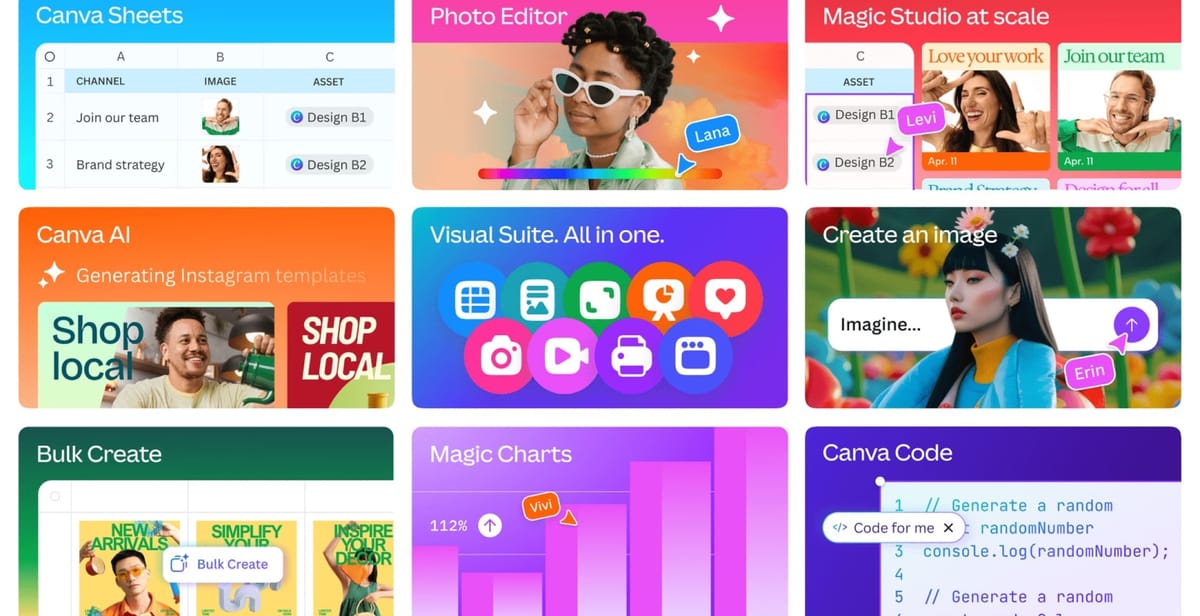
Canva just made its most ambitious play yet to become the all-in-one platform for modern work. At Canva Create 2025 in Los Angeles, the company unveiled Visual Suite 2.0, a reimagined workspace anchored by a conversational AI assistant named Canva AI, promising to take users from idea to execution without ever leaving the app—or even switching tabs.
Key Points:
- Canva AI combines all generative tools in one conversational interface
- Visual Suite 2.0 allows multiple formats in a single document
- New Canva Sheets and Code features target productivity workflows
The pitch is simple: instead of toggling between tools for writing, designing, data analysis, and web development, Canva now puts everything in one place. And it’s all powered by AI. From drafting documents to generating brand visuals, building interactive websites, or even coding a mini-app—Canva AI handles it in a single chat interface.
The transformation is centered around Canva AI, a new multimodal assistant that can design presentations, generate custom imagery, write content, edit photos, and even answer questions about your uploaded files. You describe what you want—“Design a product pitch deck for a smartwatch brand targeting Gen Z”—and Canva AI delivers a fully editable presentation, complete with branded visuals. Want changes? Just ask. It will refine the layout, rewrite the copy, or swap the imagery—on the fly. You can interact using voice or text, and it works across desktop and mobile.
But Canva didn’t stop at creativity. It’s pushing into productivity and development, too. Visual Suite 2.0 lets users mix and match formats—slides, whiteboards, docs, videos, even merch designs—in one unified file. Think: an entire campaign, from brainstorm to launch, in a single workspace. No more “final_final_FINAL_v2.pptx” chaos.
For users working with data, Canva Sheets adds spreadsheet functionality—with a twist. It’s not a boring Excel clone. It’s visual, intuitive, and built for storytelling. Features like Magic Insights and Magic Charts automatically surface key takeaways and convert numbers into animated, brand-ready visuals. Canva also introduced Magic Studio at Scale, which combines Sheets with AI tools like Magic Write, Translate, Background Remover, and Resize to generate hundreds of localized, personalized assets in minutes.
Then came Canva Code, a tool that might surprise even Canva’s most loyal users. It allows anyone—no engineering background required—to create interactive experiences like calculators, games, and custom widgets with simple text prompts. Powered by Anthropic under the hood, Canva Code compiles what you describe into usable, embeddable features for your site or presentation. During a live demo, attendees built fitness apps, language games, and e-commerce widgets—all in minutes.
This suite of updates speaks to a broader trend: Canva isn’t just competing with Adobe anymore—it’s targeting Microsoft, Google, and Notion too. The company is positioning itself as the visual productivity platform of choice for teams and enterprises that want creativity and execution under one roof. Already, brands like FedEx and Disney are using Canva Enterprise to streamline content creation across continents.
For business users, Canva's enterprise features have been enhanced with data integration capabilities, allowing teams to import information from services like HubSpot, Statista, and Google Analytics directly into their visuals.
While the launch was undeniably flashy—complete with live demos, musical numbers, and community wish-granting—beneath the showmanship was a serious product push. Canva now serves 230 million monthly users. And last month alone, users created over 1 billion designs.
One practical question users will have is whether they can use AI-generated content for commercial projects? Canva says yes—with a few caveats. Anything made using Canva AI can be used for both personal and commercial purposes, but users should keep in mind that they may not have exclusive rights to the content, and it’s on them to ensure it doesn’t infringe on existing works. The company doesn’t guarantee that generated images or designs are cleared for use if they resemble copyrighted material.
With these updates, Canva continues its evolution from a simple design tool to a comprehensive creative platform, positioning itself at the intersection of productivity software and creative applications. As businesses increasingly seek unified solutions for content creation and collaboration, Canva's latest innovations suggest the company is betting big on becoming the central hub for digital creativity in the workplace.

